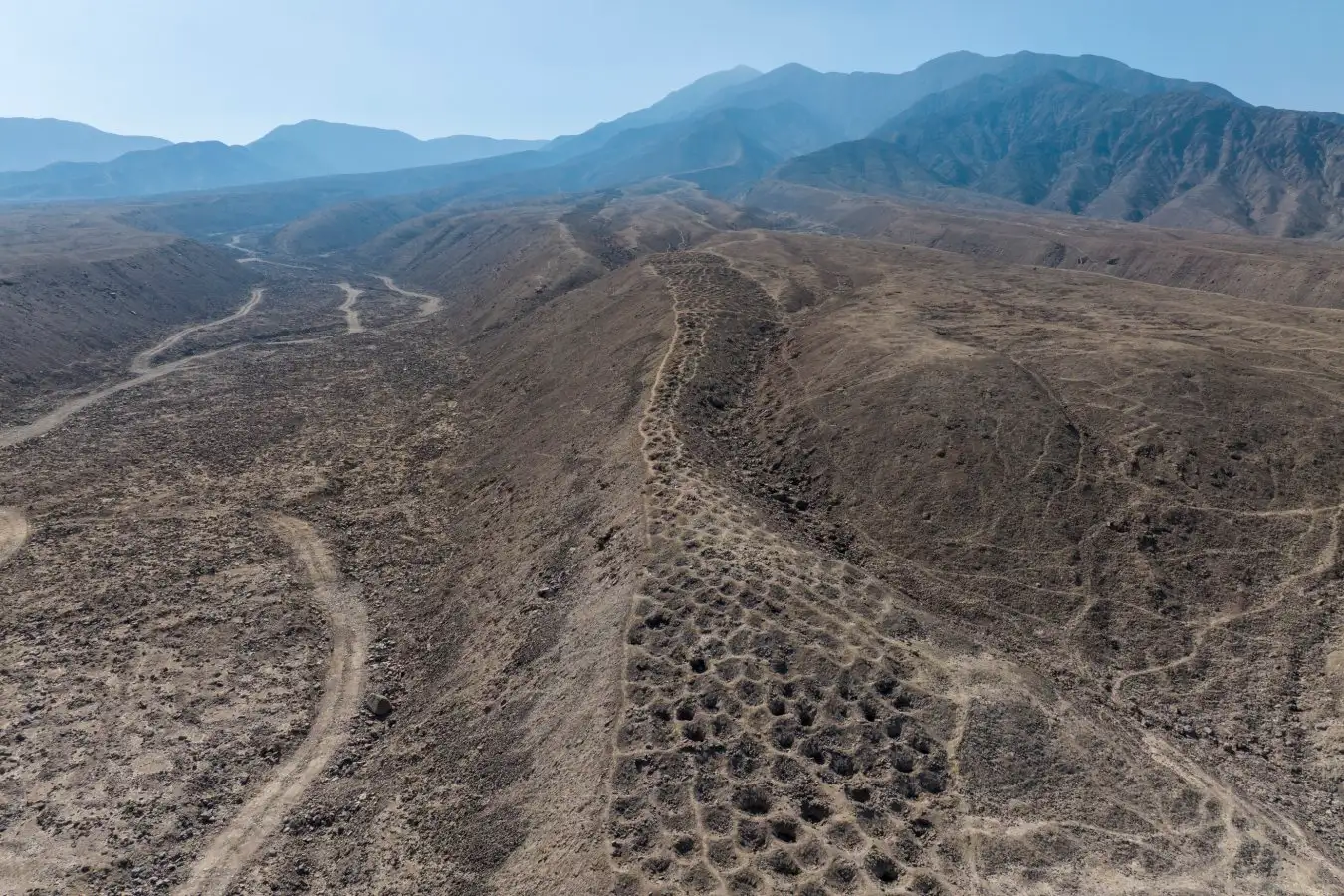
Aerial photo of the Band of Holes in Monte Sierpe, Peru
J.L. Bongers
A hillside in Peru covered by more than 5000 aligned holes may have been a giant Inca accounting device – a spreadsheet, but on a monumental scale.
Tracing across the slopes of Monte Sierpe (Serpent Mountain) in a snake-like shape, the “Band of Holes” has mystified archaeologists since an aerial photo of it was published in 1933. Various hypotheses have been put forward for the holes’ purpose, including suggestions that they are graves or defensive structures, or were used for water storage or gardening during the Inca Empire, which ran from 1438 to 1533.
“This 1.5-kilometre-long band of holes has baffled people for decades,” says Jacob Bongers at the University of Sydney.
To get a clearer idea of the purpose of the holes, Bongers and his colleagues analysed sediment samples from within 19 holes and used drones to provide the clearest aerial picture yet of the array of depressions, which are each about 1 to 2 metres across and between 50 centimetres and 1 metre deep.
The analysis revealed pollen from food crops, including maize, amaranth, chilli peppers and sweet potato, and from wild plants such as Typha (bulrush), which are traditionally used for constructing baskets and rafts.
The holes are too far from the fertile areas where the plants would grow for the pollen to have been delivered by wind, says Bongers. He suggests that local groups from the Chincha culture – which lasted from about AD 900 to 1450 – lined the holes with plant materials and deposited goods in them, brought up in woven baskets loaded onto llamas.
“The data support the idea that people brought goods to the site and deposited them in the holes,” he says, and the use of baskets would also explain why there isn’t much pottery at the site. “We think it was initially a barter marketplace. That was then turned into a sort of large-scale accounting device under the Inca.”
Around 1480, the Chincha came under Inca rule, retaining their autonomy, but historical sources indicate they also paid levies, says Bongers. The accounting device idea comes from the aerial imagery, which allowed a more precise counting of the number of holes – revealing there are about 5200 of them – and of the variation in their layout.
The holes are organised into at least 60 sections or blocks. The researchers say their layout mirrors some Inca counting devices made from knotted strings, known as khipus, which have been compared to calculators or abacuses. But Bongers says a better analogy for the hole layout might be a spreadsheet to record the collection of tributes of food or goods from local communities.
A group of holes at Monte Sierpe, Peru
C. Stanish
“There are these interesting mathematical patterns. You have some [sections with] multiple rows of eight holes, and then you have other sections that have alternating counts. Eight holes, then seven, then eight and seven, then eight. It hints that there was some sort of intention behind it,” says Bongers.
He thinks the different sections correspond to distinct groups of people from the heavily populated and productive agricultural region around Monte Sierpe. Sources suggest some 100,000 people lived in the neighbouring Pisco and Chincha valleys, he says.
The particular khipu said to resemble the layout of the holes was found in the Pisco valley, and is divided into sections approximately similar to the holes at the site, but that khipu has 80 divisions overall.
“The 5200 holes are certainly big enough to put goods into, but they are not arranged in a clear-cut decimal pattern and the Inca had a decimal system, so I would expect things to be strongly organised in groups of 10,” says Karenleigh Overmann at the University of Colorado, Colorado Springs. “The holes are organised into 60-some sections and the khipu is organised into 80, and that’s a pretty big difference in numbers.”
Bongers accepts that, but adds that we don’t actually know over what period of time the site was built, and the layout or use of holes might have evolved, along with any matching khipus. “We’re seeing the final form, but it could have started out as just a couple of sections and changed over time with the population,” he says.
The goods might have been gathered here rather than in an urban area because it is near the intersection of a network of pre-Hispanic roads, and in between two major Inca administrative sites: Tambo Colorado and Lima La Vieja.
Overmann says the study does a good job of looking at and discounting alternative ideas for the purpose of the holes, but she says there might be a simpler explanation. “There is a lot of tradition in Peru of making giant petroglyphs that can be seen from a distance,” she says. “Maybe they were just doing that.”
That could indeed have been one purpose, says Bongers. “But two things can be true at the same time. It’s a big, giant snake, but it served a functional purpose, so I see this site as a sort of social technology. They didn’t have internet, they didn’t have cell phones, so how are people figuring out when and where to meet? Let’s build a giant site that you can see from kilometres away.”
Historic Herculaneum – Uncovering Vesuvius, Pompeii and ancient Naples
Embark on a captivating journey where history and archaeology come to life through Mount Vesuvius and the ruins of Pompeii and Herculaneum.
Topics:
Source link : https://www.newscientist.com/article/2503499-mysterious-holes-in-andean-mountain-may-be-an-inca-spreadsheet/?utm_campaign=RSS%7CNSNS&utm_source=NSNS&utm_medium=RSS&utm_content=home
Author :
Publish date : 2025-11-10 00:01:00
Copyright for syndicated content belongs to the linked Source.